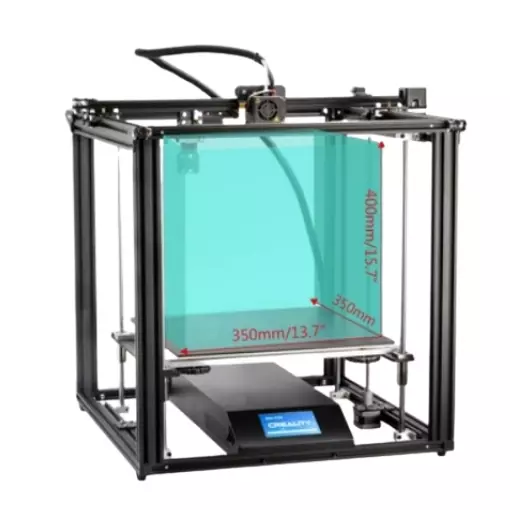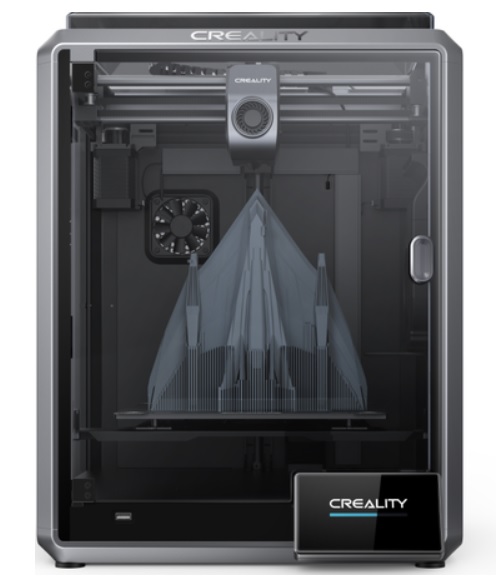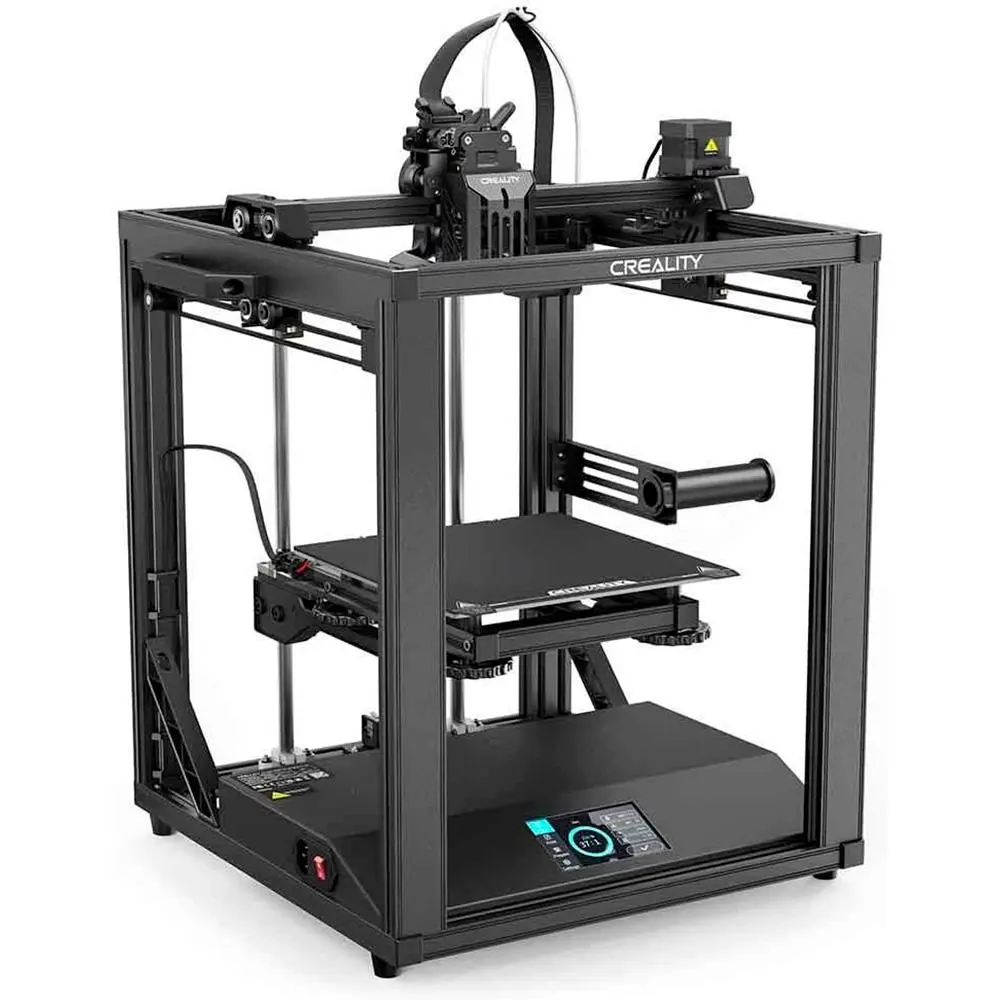Compare Ender 5 Plus vs K1 vs Ender 5 S1
Comparison between the best 3D printers
Choose the best 3D printer at the best price. The cheapest 3D printers are here.
Buy a 3D printer here with 3D Fila.
 |
 |
 |
|
| Model | Ender 5 Plus[BUY Ender 5 Plus] |
K1[BUY K1] |
Ender 5 S1 |
| Estimated price | $599,00 | $399,00 | $467,00 |
| Fabricante | Creality 3D | Creality 3D | Creality 3D |
| Release Year | 2019 | 2023 | 2022 |
| Print Volume [mm] | 350x350x400 | 220x220x250 | 220x220x280 |
| Printer Size [mm] | 632x619x666 | 355x355x480 | 425x460x570 |
| Weight [kg] | 18,2 | 12,5 | 12,1 |
| Power Loss Recovery | YES | YES | YES |
| Enclosed printer | NO | YES | NO |
| Bed Leveling | Automatic | Automatic | Automatic |
| Filament End Sensor | YES | YES | YES |
| Bed type | Heated | Heated | Heated |
| Power supply system | Bowden | Direct Drive | Direct Drive |
| Standard nozzle | 0,4 | 0,4 | 0,4 |
| Maximum Nozzle Temperature [°C] | 260 | 300 | 300 |
| Maximum Bed Temperature [°C] | 100 | 120 | 110 |
| Maximum printing speed [mm/s] | 180 | 600 | 250 |
| Filament holder | YES | YES | YES |
| Camera for supervision | NO | NO | NO |
| Recommended filaments | PLA, TPU, ABS, PETG | ABS, PLA, PETG, PET, TPU, PA, ABS, ASA, PC, PLA-CF, PA-CF, PET-CF | PLA, ABS, PETG, TPU, PC, ASA, HIPS |
| Recommended slicers | Cura, Simplify, Slic3r | Creality Print; Cura, Simplify3D e PrusaSlicer | Cura, Simplify, Slic3r, IdeaMaker |
| Maximum Resolution [mm] | 0,1 | 0,1 | 0,05 |
| Processor | 32 bits | 32 Bits | |
| Display | Touchscreen TFT 4,3'' | Display touchscreen 4,3'' | Display touchscreen 4,3 '' |
| Power Supply | 24V / 504W | 110/220V / 350W | 350 W |
| Connectivity | SD / USB | Ethernet / USB / Wi-Fi | SD / USB / Wi-Fi |
| Operating systems | Windows, Mac, Linux | Windows, Mac, Linux | Windows, Mac, Linux |
| Date of registration in the system | 2021-04-14 | 2023-04-17 | 2023-10-04 |
| Release date | 2019 | 2023 | 2022 |
| Extra features | The Ender 5 Plus offers a large print volume (350x350x400 mm) and fast assembly. It includes a BLTouch sensor, but with range limitations. It stands out for its dimensional accuracy, although it requires adjustments to the slicer settings. Despite the noise, its integrated design saves space, and includes features such as a filament sensor and power resumption. Ideal for large projects, it requires refinement in the settings for high-quality prints. | The K1 is an extremely fast FDM 3D printer, reaching 600mm/s, 12 times faster than standard models. Equipped with a Core XY system and lightweight print head, it offers energy efficiency and high print quality. It stands out for its dual-gear extruder and quickly heated hotend, as well as dual cooling to prevent warping. Its robust structure ensures stability at high speed, with optimized software to speed up the printing process. | A steel drive shaft synchronizes the two Y-axis belts. High-torque 42-48 Y-axis motor for responsive and precise movement. Cartesian structure. Enhanced stability by thick linear shafts, extra stiffeners, two cantilevers, and silicone bumpers. Double Die Spring profile reinforcement. Silicone bed support. All-metal Sprite direct extruder. Best for printing with flexible filaments like TPU. Auto-calibration with 16-point CR Touch. Compatible with Sonic Pad, Wifi Box, and Camera kit. |
| Support for multiple colors and materials (AMS and CFS) | NO | NO | NO |
Notes * |
|||
| Cost-benefit | 6 / 10 | 8 / 10 | 7 / 10 |
| Hardware | 2 / 10 | 4.8 / 10 | 2.8 / 10 |
| Screen | . | . | . |
| Print volume | 4 / 10 | 3 / 10 | 3 / 10 |
| Performance | 1 / 10 | 5 / 10 | 2 / 10 |
| [BUY Ender 5 Plus] | [BUY K1] |
Conclusion |
| In comparing the Ender 5 Plus, K1, and Ender 5 S1 3D printers, a few key differences and advantages emerge, allowing potential buyers to evaluate which model best meets their needs. The **Ender 5 Plus** offers the largest print volume, making it ideal for larger projects. Its build quality is robust, but it may require some adjustments in slicer settings for optimal performance. Despite being slightly more expensive, its dimensional accuracy appeals to those focused on precision. However, its performance at high speeds is limited compared to the newer models. On the other hand, the **K1** stands out as a top contender for speed and efficiency, boasting a maximum printing speed of 600mm/s. This printer employs advanced design features like a Core XY system and dual-gear extruder, catering well to users looking for fast production without sacrificing quality. Its modern features and connectivity options add further value, especially for those interested in integrating it into a more connected workflow. Finally, the **Ender 5 S1** offers a middle-ground solution, balancing print quality with compatibility for various filaments. Although it has a smaller print volume compared to the Ender 5 Plus, it shares similar modern features, such as a direct drive system, which can enhance performance, especially while printing flexible materials. When considering price, the K1 emerges as the best value for those prioritizing speed and advanced features, while the Ender 5 Plus is ideal for users focused on larger prints and precision. The Ender 5 S1 sits in a versatile position but may not compete directly with the performance of the other two models. In conclusion, the choice between these three 3D printers should be guided by specific needs: the K1 for speed and efficiency, the Ender 5 Plus for large and accurate prints, and the Ender 5 S1 for a balanced approach with good versatility across different materials. |

